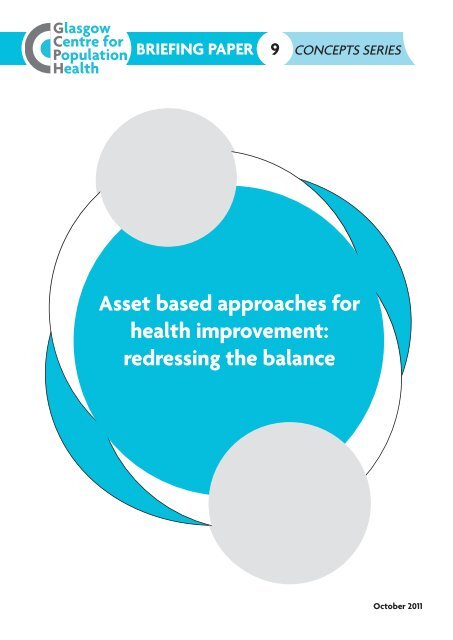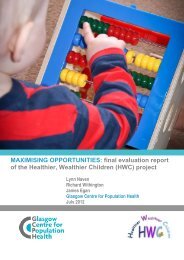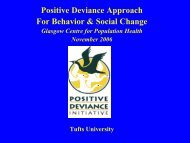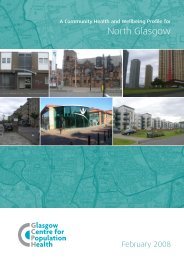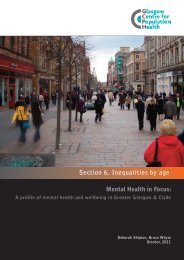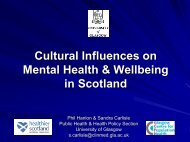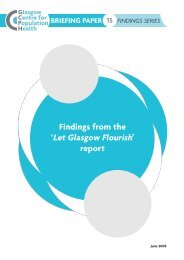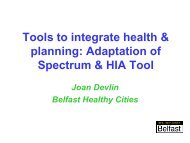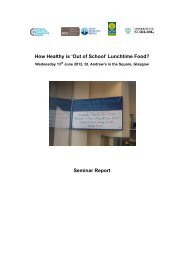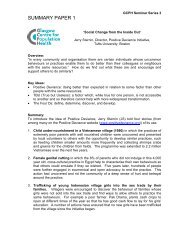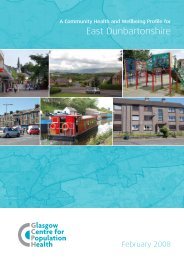Asset based approaches for health improvement - Assett Based ...
Asset based approaches for health improvement - Assett Based ...
Asset based approaches for health improvement - Assett Based ...
You also want an ePaper? Increase the reach of your titles
YUMPU automatically turns print PDFs into web optimized ePapers that Google loves.
BRIEFING PAPER 9 CONCEPTS SERIES<strong>Asset</strong> <strong>based</strong> <strong>approaches</strong> <strong>for</strong><strong>health</strong> <strong>improvement</strong>:redressing the balanceOctober 2011
CONCEPTS SERIES9BRIEFING PAPERKEY MESSAGES:<strong>Asset</strong> <strong>based</strong> <strong>approaches</strong> <strong>for</strong> <strong>health</strong> <strong>improvement</strong>: redressing the balance• The shortcomings of taking a ‘deficits’ or ‘treatment’ approach to the delivery ofpublic services, coupled with the impending cuts to public service provision, havegiven a renewed impetus to finding better ways of working.• <strong>Asset</strong>s can be described as the collective resources which individuals andcommunities have at their disposal, which protect against negative <strong>health</strong>outcomes and promote <strong>health</strong> status. Although <strong>health</strong> assets are a part of everyperson, they are not necessarily used purposefully or mindfully.• An asset <strong>based</strong> approach makes visible and values the skills, knowledge,connections and potential in a community. It promotes capacity, connectednessand social capital.• <strong>Asset</strong> <strong>based</strong> <strong>approaches</strong> emphasise the need to redress the balance betweenmeeting needs and nurturing the strengths and resources of people andcommunities.• <strong>Asset</strong> <strong>based</strong> <strong>approaches</strong> are concerned with identifying the protective factorsthat support <strong>health</strong> and wellbeing. They offer the potential to enhance both thequality and longevity of life through focusing on the resources that promote theself-esteem and coping abilities of individuals and communities.• <strong>Asset</strong> <strong>based</strong> <strong>approaches</strong> are not a replacement <strong>for</strong> investing in service<strong>improvement</strong> or attempting to address the structural causes of <strong>health</strong> inequalities.• Measuring the impact of asset <strong>based</strong> <strong>approaches</strong> on <strong>health</strong> outcomes is complex,and evidence of the effectiveness of these <strong>approaches</strong> at present largely comesfrom case studies and small scale exploratory research.• The move to including asset <strong>based</strong> <strong>approaches</strong> as an integral part of mainstreamservice delivery will require a change in individual and organisational attitudes,values and practice.2
BRIEFING PAPER 9 CONCEPTS SERIESINTRODUCTIONFor too long, it can be argued, professionals have concentrated on the problems, needs anddeficiencies within communities. How we understand <strong>health</strong> and wellbeing determines theway we respond to it. Typically a community is seen from the perspective of its largestdeficit. Assessing and building the strengths of individuals and the assets of a communityopens the door to new ways of thinking about improving <strong>health</strong> and of responding to poor<strong>health</strong>.Although many public <strong>health</strong> programmes have achieved considerable success in reducingmortality and morbidity, they often fail to capitalise on interventions that address thesocial context and conditions in which people grow, live, work and age, all of which have apowerful influence on <strong>health</strong>. Many of the key assets required <strong>for</strong> creating the conditions<strong>for</strong> <strong>health</strong> lie within the social context of people’s lives and there<strong>for</strong>e have the potential tocontribute to reducing inequalities.Despite extensive ef<strong>for</strong>ts to improve <strong>health</strong>, concern continues to grow over the wideninggap in <strong>health</strong> inequalities in Scotland and the UK as a whole and new thinking about how toaddress this more effectively is developing. For example, one of the key messages of TheMarmot Review - Fair Society, Healthy Lives (2010; p.15) is that “Effective local deliveryrequires effective participatory decision-making at local levels. This can only happen byempowering individuals and local communities”. <strong>Asset</strong> <strong>based</strong> <strong>approaches</strong> provide an idealopportunity <strong>for</strong> public bodies and their partners to respond to this challenge. Healthservices and local public services are all facing cuts in funding. Demographic and socialchange means that more people are going to be in need of help and support (Foot andHopkins, 2010). New ways of working with individuals and communities will be needed ifinequalities in <strong>health</strong> and wellbeing are to be prevented from widening further.The recently published Commission on the Future Delivery of Public Services (Christie, 2011;p.viii) report has also highlighted and rein<strong>for</strong>ced the need <strong>for</strong> new ways of working. Thereport clearly states that “irrespective of the current economic challenges, a radical changein the design and delivery of public services is necessary to tackle the deep-rooted socialproblems that persist in communities across the country”. To achieve this goal, a keyobjective of the re<strong>for</strong>m programme must there<strong>for</strong>e be to ensure that “public services arebuilt around people and communities, their needs, aspirations, capacities and skills, andwork to build up their autonomy and resilience” (Christie, 2011; p.26). Central to this re<strong>for</strong>mprocess is the empowerment of individuals and local communities by involving them indesigning and delivering the services they use and the requirement <strong>for</strong> public services towork in partnership with other organisations and communities to improve outcomes.The aim of this briefing paper is to present the current evidence and thinking on asset <strong>based</strong><strong>approaches</strong> <strong>for</strong> <strong>health</strong> <strong>improvement</strong>, the background and rationale <strong>for</strong> these <strong>approaches</strong>,and the practical challenges of adopting these <strong>approaches</strong> in reality. It is also hoped thatthis paper will help stimulate policy makers, practitioners and researchers to thinkdifferently about how they might minimise the risks of widening <strong>health</strong> inequalities andapproach the goal of improving the <strong>health</strong> of communities and populations. The discussionwhich follows summarises the thinking and propositions found in the literature and a rangeof sources of evidence on asset <strong>based</strong> <strong>approaches</strong> <strong>for</strong> <strong>health</strong> <strong>improvement</strong>. This will befurther explored and tested through practical application and implementation of these<strong>approaches</strong> in Scotland.<strong>Asset</strong> <strong>based</strong> <strong>approaches</strong> <strong>for</strong> <strong>health</strong> <strong>improvement</strong>: redressing the balance3
CONCEPTS SERIES9BRIEFING PAPERWHAT IS AN ASSET?<strong>Asset</strong> <strong>based</strong> <strong>approaches</strong> <strong>for</strong> <strong>health</strong> <strong>improvement</strong>: redressing the balance4“A <strong>health</strong> asset is any factor or resource which enhances the ability of individuals,communities and populations to maintain and sustain <strong>health</strong> and wellbeing and to help toreduce <strong>health</strong> inequalities. These assets can operate at the level of the individual, family orcommunity and population as protective and promoting factors to buffer against life’sstresses” (Morgan and Ziglio, 2007; p.18).<strong>Asset</strong>s can there<strong>for</strong>e be described as the collective resources which individuals andcommunities have at their disposal, which protect against negative <strong>health</strong> outcomes andpromote <strong>health</strong> status. These assets can be social, financial, physical, environmental, orhuman resources, <strong>for</strong> example employment, education, and supportive social networks(Harrison et al., 2004).Practically speaking assets can there<strong>for</strong>e be (Foot and Hopkins, 2010):• the practical skills, capacity and knowledge of local residents• the passions and interests of local people that give the energy to change• the networks and connections in a community• the effectiveness of local community and voluntary associations• the resources of public, private and third sector organisations that are availableto support a community• the physical and economic resources of a place that enhance wellbeing.<strong>Asset</strong> <strong>based</strong> <strong>approaches</strong> value the capacity, skills and knowledge and connections inindividuals and communities. They focus on the positive capacity of individuals andcommunities rather than solely on their needs, deficits and problems. These assets can actas the foundation from which to build a positive future. The identification and mobilisationof an individual’s or a community’s assets can help them overcome some of the challengesthey face.The literature identifies the antecedents of <strong>health</strong> assets, both innate and acquired, as anindividual’s genes, values, beliefs and life experiences (Rotegard et al., 2010). This means it ispossible to identify <strong>health</strong> promoting or protecting assets from across the domains of<strong>health</strong> determinants including our personal and individual characteristics, our socialcircumstances, the environmental conditions in which we live and work, the behaviouralchoices we make and the <strong>health</strong> services we engage with.Health and development assets span individual, community and organisational levels(Morgan and Ziglio, 2007). Identification of assets across these three levels would, as aminimum include at the:• individual level: resilience, self-esteem and sense of purpose, commitment to learning• community level: family and friendship or supportive networks, intergenerationalsolidarity, community cohesion, religious tolerance and harmony• organisational level: environmental resources necessary <strong>for</strong> promoting physical,mental and social <strong>health</strong>, employment security and opportunity <strong>for</strong> voluntary service,religious tolerance and harmony, safe and pleasant housing, political democracy andsocial justice.Although <strong>health</strong> assets are a part of every person, they are not necessarily usedpurposefully or mindfully. The literature supports the premise that <strong>health</strong> assets, eitherinternal or external, can be leveraged and utilised in challenging situations, but how and ifthey are used depends on the individual (Rotegard et al., 2010).
BRIEFING PAPER 9CONCEPTS SERIESBUILDING ASSETS<strong>Asset</strong> <strong>based</strong> <strong>approaches</strong> or positive <strong>approaches</strong> <strong>for</strong> improving <strong>health</strong> are not new. Thisconcept has developed widely over the last few decades and such <strong>approaches</strong> are used bydifferent <strong>health</strong> disciplines. Early psychiatry literature refers to the importance of ‘assets’ asa foundation <strong>for</strong> managing change (Beiser, 1971), and the <strong>health</strong> assets concept wasintroduced to nursing practice in the 1980s (Barkauskas, 1983). The term ‘<strong>health</strong> asset’ is alsoused in psychology (Petersen and Seligman, 2004), social sciences (Kolm, 2002) and moreextensively in public <strong>health</strong> (Murray and Chen, 1993; Halfon and Hochstein, 2002; Friedl et al.,2005). The public <strong>health</strong> literature focuses on developmental and environmental aspects of<strong>health</strong> assets discussed in the context of individuals (early childhood, youth), family andcommunity (French et al., 2001; Atkins et al., 2002; Murphey et al., 2004; Kegler et al., 2005).Community development <strong>approaches</strong>, founded on asset principles and participatory innature, have operated in diverse contexts around the world under a range of names <strong>for</strong> manyyears. These include: Strengths <strong>Based</strong> Approaches (USA), Sustainable Livelihoods Approach(UK), Paulo Freire Liberation Theology (Brazil), Self Reliance Movement (Tanzania, East Africa)and Training <strong>for</strong> Trans<strong>for</strong>mation (South Africa) (O’Leary et al., 2011). As in<strong>for</strong>mation andpractitioners move around the world, these <strong>approaches</strong> continue to evolve and adapt tolocal contexts.<strong>Asset</strong> <strong>based</strong> <strong>approaches</strong> are already operating effectively in a number of areas acrossScotland. Many examples of asset <strong>based</strong> work may not use ‘asset’ terminology but may useother terms such as ‘community engagement’, ‘community development’, ‘enablement’,‘recovery’, ‘self-management’, ‘community empowerment’ and ‘mutuality’ to describe theirapproach. These terms all however share the key features of asset <strong>based</strong> <strong>approaches</strong> whichvalue the positive capacity, skills and knowledge and connections in a community.REBALANCING ASSETS AND NEEDS<strong>Asset</strong> <strong>based</strong> <strong>approaches</strong> are concerned with identifying the protective factors that support<strong>health</strong> and wellbeing. They offer the potential to enhance both the quality and longevity oflife through focusing on the resources that promote the self-esteem and coping abilities ofindividuals and communities (Morgan et al., 2010).Traditionally, <strong>health</strong> care services have focused on identifying the actual or potential <strong>health</strong>problems of individuals and providing interventions to solve, alleviate, or prevent thoseproblems. At a population level, this more familiar ‘deficit’ approach focuses on problems,needs and deficiencies – such as deprivation, illness and <strong>health</strong> damaging behaviours. Itdesigns services to fill the gaps and fix the problems. From this perspective, the primaryemphasis of problem oriented care is on professional observations and interventions onbehalf of the individual, with little focus on enhancing the individuals’ strengths andcapabilities (Rotegard et al., 2010). Furthermore, this perspective pays little attention to anindividual’s experiences, preferences, perspectives and knowledge. As a result, individualscan feel disempowered and dependent on services; people can become passive recipients ofservices rather than active agents in their own lives (Foot and Hopkins, 2010). Accentuatingthe positive capabilities and nurturing the strengths and resources of people may there<strong>for</strong>eallow them to identify problems and activate solutions <strong>for</strong> <strong>health</strong> and wellbeing thatpromote their self-esteem and resilience, leading to less reliance on professional servicesand to improved <strong>health</strong> outcomes.<strong>Asset</strong> <strong>based</strong> <strong>approaches</strong> <strong>for</strong> <strong>health</strong> <strong>improvement</strong>: redressing the balance5
CONCEPTS SERIES9BRIEFING PAPER<strong>Asset</strong> <strong>based</strong> <strong>approaches</strong> <strong>for</strong> <strong>health</strong> <strong>improvement</strong>: redressing the balance6Understanding people in totality also resonates with earlier articulations of the socialmodel of <strong>health</strong> (Dahlgren and Whitehead, 1991) which challenged the deficit approach ofthe medical model, and proposed the need <strong>for</strong> services to be more aware and recognise theimpact of people’s wider environment and individual experiences and choices on <strong>health</strong>(WHO, 1986).Likewise, most vulnerable or marginalised communities in our society, as well as havingneeds and problems, also have social, cultural and material assets. Identifying andmobilising these assets and strengths can help them overcome the challenges they face. Agrowing body of evidence shows that when services begin with a focus on whatcommunities have (their assets) as opposed to what they do not have (their needs) acommunity’s efficacy in addressing its own needs increases, as does its capacity to leverexternal support (Foot and Hopkins, 2010). <strong>Asset</strong> <strong>based</strong> <strong>approaches</strong> support the building oflocal networks that create reciprocity, mutual help, supportive friendships and the capacityto act together in their shared interests. Such <strong>approaches</strong> rally and foster the resources inevery community. A strong sense of community, active citizens and empowered andindependent organisations and networks can create solutions to activate change. They canstrengthen the ability of individuals and communities to act as co-producers of <strong>health</strong>rather than simply consumers, reducing demand on scarce resources. An asset <strong>based</strong>approach may also help communities to develop a greater confidence and a stronger voicewith which to engage with systems in addressing structural causes of injustice andinequalities.<strong>Asset</strong> <strong>based</strong> <strong>approaches</strong> do not replace investment in improving services or tackling thestructural causes of <strong>health</strong> inequalities. They may however reduce demand and dependencyon services in the long term and bring about more effective and efficient services. The case<strong>for</strong> asset working rests on achieving a better balance between responding to needs,providing the services that only public services and governments can do, and respecting theresources and potential of asset rich individuals and communities.ASSETS IN ACTIONAdopting an asset <strong>based</strong> approach to traditional epidemiological risk factors could providenew ways of challenging <strong>health</strong> inequalities, improving wellbeing, changing attitudes,strengthening local communities and complementing mainstream service delivery.Reducing <strong>health</strong> inequalitiesReducing the gap in <strong>health</strong> inequalities is a matter of fairness and social justice. Creating afairer society is fundamental to improving the <strong>health</strong> of the whole population and ensuringa fairer distribution of good <strong>health</strong> (Marmot, 2010). In Scotland, extensive and far-reachingef<strong>for</strong>ts to improve <strong>health</strong> and wellbeing over the last few decades have produced steady<strong>improvement</strong>s in <strong>health</strong>. However the <strong>health</strong>y life expectancy of the most deprivedcommunities has increased at a slower rate than that of the most affluent communities(Scottish Government, 2009) so the gap is getting wider. Current <strong>approaches</strong> are notworking, or are not working well enough to reduce <strong>health</strong> inequalities.While there is an extensive body of evidence describing which groups and populationssuffer the worst <strong>health</strong> and what the social, behavioural and environmental risk factors are,there is little definitive evidence on how best to act to reduce the gap between populationsand improve <strong>health</strong> and wellbeing. As reported in a number of national and internationalreviews, there is a lack of evidence about the effectiveness and cost-effectiveness ofpolicies, programmes and projects in reducing inequalities in <strong>health</strong> (Scottish Government,2008; WHO, 2008).
BRIEFING PAPER 9CONCEPTS SERIESWhile an asset <strong>based</strong> approach will not on its own tackle <strong>health</strong> inequalities, a number ofasset principles may provide support towards achieving that goal alongside existing ef<strong>for</strong>ts.These include (Foot and Hopkins, 2010):• targeting appropriate areas or communities to work in• allowing time <strong>for</strong> communities to realise and acknowledge their individualand collective assets and to rebuild their confidence and networks• using asset <strong>based</strong> methods or techniques that enable local people to takethe lead• rebuilding trust with communities by making changes in services.However, on the other hand, it is also conceivable that the adoption of asset <strong>based</strong><strong>approaches</strong> may increase <strong>health</strong> inequalities. There is evidence that more advantagedgroups in society find it easier to change their <strong>health</strong> behaviours due to better access toresources such as time, finance and the coping skills to uptake <strong>health</strong> promotion advice andpreventative services (Macintyre, 2007). It will there<strong>for</strong>e be important to carefully considerwhat <strong>approaches</strong> are encouraged and the methods and techniques which are used toengage communities and individuals to prevent increasing <strong>health</strong> inequalities. Some of themost powerful influences on behaviour change are friends and family, and a collective senseof self-esteem, helping people believe that it is possible to take positive actions to improve<strong>health</strong> and wellbeing (Foot and Hopkins, 2010).Improving wellbeingThe concept of wellbeing is about lives going well. It is the combination of feeling good andfunctioning well (Hubbert, 2009). Feelings of happiness, contentment, enjoyment, curiosityand engagement are characteristics of someone who has a positive experience of life.Equally important <strong>for</strong> wellbeing is our functioning in the world. Experiencing positiverelationships, having some control over one’s life and having a sense of purpose are allimportant attributes of wellbeing (Hubbert, 2009). These ‘assets’ determine an individual’slevel of personal wellbeing and their ability to interact and engage with the community andworld around them.In recent years, there has been a noticeable shift of focus in the wellbeing researchliterature from an emphasis on disorder and illness (deficits approach) to a focus onwellbeing (assets approach). In a review of the evidence on how individuals can improvewellbeing, the New Economics Foundation (Aked et al., 2008), as part of the UKGovernment’s Foresight project, identified five actions to improve wellbeing thatindividuals could be encouraged to build into their lives:1. Connect – developing strong relationships and social networks2. Be active – more exercise and play improves wellbeing3. Take notice – self-awareness and the importance of developing social and emotionalliteracy4. Keep learning – social interaction, self-esteem and feelings of competency5. Give – reciprocity, trust and helping others – studies show that co-operative behaviouractivates the reward area of the brain.<strong>Asset</strong> <strong>based</strong> <strong>approaches</strong> <strong>for</strong> <strong>health</strong> <strong>improvement</strong>: redressing the balance7
BRIEFING PAPER 9CONCEPTS SERIESWHAT THEORY UNDERPINS TAKING ASSET BASED APPROACHES FORHEALTH IMPROVEMENT?<strong>Asset</strong> <strong>based</strong> <strong>approaches</strong> <strong>for</strong> evidence in<strong>for</strong>med public <strong>health</strong> recognise that interventionswhich focus on the needs or problems of populations are not sufficient <strong>for</strong> bringing aboutsustainable and equitable results. An asset <strong>based</strong> approach draws on a number ofperspectives to help us understand the causes and mechanisms of inequities in <strong>health</strong> andpotential solutions. This includes drawing on the theory of salutogenesis to investigate thekey (salutogenic) factors or <strong>health</strong> assets that support the creation of <strong>health</strong> rather than theprevention of disease. In particular, it promotes the possibilities <strong>for</strong> individuals andcommunities to be co-producers of <strong>health</strong> rather than simply consumers of <strong>health</strong> careservices. In doing so it emphasises the need <strong>for</strong> a focus on positive ability, capability, andcapacity leading to less reliance on professional services, and reductions in the demand <strong>for</strong>scarce resources.This perspective allows us to identify those factors which keep individuals from movingtowards the disease end of the spectrum (Lindström and Eriksson, 2006). It can also help usto identify the combination of ‘<strong>health</strong> assets’ that are most likely to lead to higher levels ofoverall <strong>health</strong>, wellbeing and achievement. Specifically, the concept embraces the need tofocus on people’s resources and capacity to create <strong>health</strong> (Morgan and Ziglio, 2007). It isargued that the more individuals understand the world they live in, the more they canutilise the resources they have themselves and around them to maintain their own <strong>health</strong>.SalutogenesisCreating positive <strong>health</strong>, or salutogenesis, and developing ways to use this concept in <strong>health</strong>care has grown steadily over the past two decades, and has influenced discussions abouthow <strong>health</strong> is maintained and how <strong>health</strong> care is delivered. A salutogenic approach providesa particular perspective to the way <strong>health</strong> is viewed, which is centred on the discovery anduse of personal resources (or assets), either inside a person or in the environment, thatmaintain a <strong>health</strong>y status. This is opposed to the traditional view of <strong>health</strong> care, whichfocuses on the search <strong>for</strong> the causes of disease. In particular, theories about salutogenesisaim to explain why some people fall ill under stressful conditions and others do not.The salutogenic approach has been described as a deep personal way of being, thinking andacting, a feeling of inner trust that things will be in order independent of whatever happens(Lindström and Eriksson, 2005). The core salutogenic concepts are Generalised ResistanceResources (GRRs) and a Sense of Coherence (SoC). GRRs are biological, material andpsychosocial factors which make it easier <strong>for</strong> people to understand and structure theirlives. They include factors such as money, social support, knowledge, experience,intelligence and traditions. It is believed that if people have these kinds of resourcesavailable to them or in their immediate surroundings, there is a better chance they will beable to deal with the challenges of life (Lindström and Eriksson, 2005). While GRRs identifyimportant ‘ingredients’, a sense of coherence (SoC) provides the capability to use them.<strong>Asset</strong> <strong>based</strong> <strong>approaches</strong> <strong>for</strong> <strong>health</strong> <strong>improvement</strong>: redressing the balanceSoC is a positive way of looking at life alongside an ability to successfully manage the manystresses encountered throughout life. SoC is described as a mediator between a GRR (orasset) and an outcome of improved <strong>health</strong> and wellbeing, coping and control. SoC maythere<strong>for</strong>e be the part of self-awareness (mobilisation) that releases one’s <strong>health</strong> assets.Three types of life experiences shape an individual’s sense of coherence (Antonovsky, 1993):• comprehensibility (life has a certain predictability and can be understood)• manageability (resources are enough to meet personal demands)• meaningfulness (life makes sense, problems are worth investing energy in)9
CONCEPTS SERIES9BRIEFING PAPER<strong>Asset</strong> <strong>based</strong> <strong>approaches</strong> <strong>for</strong> <strong>health</strong> <strong>improvement</strong>: redressing the balance10More recently, a fourth concept has been added, emotional closeness, which refers to theextent to which a person has emotional bonds with others and feels part of theircommunity (Sagy and Antonovsky, 2000).A recent systematic review came to the conclusion that the salutogenic model is a <strong>health</strong>promoting resource in that it defines the means by which individual resilience may beimproved and people may be helped to feel physically and mentally <strong>health</strong>y, with a goodquality of life and sense of wellbeing (Eriksson and Lindström, 2006). However, while thesalutogenic approach provides us with a theory through which we can understand how<strong>health</strong> comes about and can be maintained, there is little evidence at present of howsalutogenic concepts can be put to good use in policies to help people and communities.WHY DOES SCOTLAND ENDORSE THIS APPROACH?To embed and endorse asset <strong>based</strong> <strong>approaches</strong> in Scotland the identification andstrengthening of <strong>health</strong> assets need to be key components in national and local <strong>health</strong> andsocial policies.<strong>Asset</strong> <strong>based</strong> <strong>approaches</strong> build on a long history of investment by the Scottish Governmentand NHS Scotland in community led <strong>approaches</strong> to <strong>health</strong> <strong>improvement</strong>. Specifically these<strong>approaches</strong> and ways of thinking have been highlighted and rein<strong>for</strong>ced by the 2009 AnnualReport of the Chief Medical Officer (Scottish Government, 2010). The Chief MedicalOfficer asks whether ‘it is time to (consider a) change’ in the methods we currently use toimprove <strong>health</strong> and to move to more upstream asset <strong>based</strong> <strong>approaches</strong> to improve <strong>health</strong>outcomes. He proposes that asset <strong>based</strong> <strong>approaches</strong> may provide the necessary step changein <strong>health</strong> creation which Scotland needs to accelerate gains in <strong>health</strong>y life expectancyacross the population.From a Scottish <strong>health</strong> policy point of view, clear support <strong>for</strong> and links to an asset <strong>based</strong>approach are already evident as detailed in the examples below:• Equally WellThe 2010 Review of Equally Well, the Ministerial Task Force on Health Inequalities,promotes asset <strong>based</strong> <strong>approaches</strong> as a means <strong>for</strong> tackling the underlying causes of <strong>health</strong>inequalities (Scottish Government, 2010). Many of the Equally Well test sites are adoptingasset <strong>based</strong> <strong>approaches</strong> when working with local individuals and communities.• Scottish Government community led initiativesCommunity led <strong>approaches</strong> to <strong>health</strong> <strong>improvement</strong> focus on supporting communitiesexperiencing disadvantage and poor <strong>health</strong> outcomes. Support and investment tocommunities is provided through the delivery of the Community Health Exchange (CHEX)and the Health Issues in the Community (HIIC) capacity building programme.• <strong>Asset</strong>s Alliance ScotlandTo provide support and endorsement <strong>for</strong> embedding asset <strong>based</strong> <strong>approaches</strong> in Scotland,in December 2010, the Scottish Government, in partnership with the Scottish CommunityDevelopment Centre (SCDC) and the Long Term Conditions Alliance Scotland (LTCAS), heldan event designed to take <strong>for</strong>ward the <strong>Asset</strong>s Alliance in Scotland (SCDC, 2011). Initiatedand supported by the Chief Medical Officer <strong>for</strong> Scotland, the event recognised that asset<strong>based</strong> <strong>approaches</strong> are not new and that many initiatives in Scotland already demonstrateworking this way. Communicating and promoting the value of an assets <strong>based</strong> approach,enhancing and further developing what already exists, and the Alliance being a centralpoint <strong>for</strong> knowledge and experience exchange were some suggestions on the future <strong>for</strong>mand key functions of a meaningful, productive and influential <strong>Asset</strong>s Alliance in Scotland.
BRIEFING PAPER 9CONCEPTS SERIES• Mental <strong>health</strong> <strong>improvement</strong>Mental <strong>health</strong> <strong>improvement</strong> is a national public <strong>health</strong> priority <strong>for</strong> Scotland. Recognisingan individual’s assets is a key principle underpinning good mental wellbeing. The conceptof mental wellbeing includes both how people feel – their emotions and life satisfaction –and how people function – their self acceptance, positive relations with others, personalcontrol over their environment, purpose in life and autonomy (Scottish Government,2009).Until recently, there had been no assessment of the overall mental <strong>health</strong> of Scotland’spopulation, without which it is difficult to determine whether mental <strong>health</strong> is improvingin Scotland. There is now however a growing number of scales designed to measurepositive mental <strong>health</strong> and wellbeing (Parkinson, 2008) and the distinction betweenmeasuring mental illness and measuring mental <strong>health</strong> is now <strong>for</strong>mally recognised inScotland, in the Warwick and Edinburgh Mental Wellbeing Scale (WEMWBS) (Parkinson,2006).To further embed this approach in mainstream service delivery, community developmentand engagement, and policy and practice, Scotland must continue to recognise and build onthe positive aspects and collective abilities of individuals and communities instead offocusing on the negatives, and support individuals and communities to have more controlover their own circumstances.IMPLEMENTING ASSET BASED APPROACHES: PRACTICAL CHALLENGESImplementing asset <strong>based</strong> <strong>approaches</strong> in Scotland will be a complex undertaking and willrequire capacity and commitment to work across traditional professional and organisationalboundaries. It is unclear from the evidence available at present how the underpinningconcept and supporting theory will translate into effective practice and how adopting thisapproach will impact on how services are currently organised, undertaken and delivered.This will require public services and their partners to reframe their models of servicedelivery in <strong>health</strong>, social care and beyond. The move to including asset <strong>based</strong> <strong>approaches</strong> asa normal part of the way services are delivered will require a change in individual mindsetand in organisational values, attitudes and beliefs. This important step may pose a majorchallenge as shown with previous experience of organisational change and restructuringand the introduction of the personalisation agenda in England (HM Government, 2007). Formany staff and professionals this represents a new way of working, and training and skillsdevelopment will be required, a further demand on our public services within the currenteconomic climate.Adopting an asset <strong>based</strong> approach is community led, long term, open ended and has lesscertain, unpredictable outcomes, which are likely to take time to emerge. This approach isnot a ‘one size fits all’ approach and will require careful negotiation on an individual basiswhen working with communities and the building of trust between community membersand professional staff. The nature of an asset <strong>based</strong> approach means that it is a bottom upway of working, with each community recognising and combining their assets and definingtheir ambitions in a very local way. It will also be important to distinguish between the‘needs’ that can be met by family, friends and social networks, those that will be best metthrough cooperation between services and communities, and those that can only bedelivered through mainstream services. This will not happen on its own; it will need to bemapped, planned and commissioned.<strong>Asset</strong> <strong>based</strong> <strong>approaches</strong> <strong>for</strong> <strong>health</strong> <strong>improvement</strong>: redressing the balance11
CONCEPTS SERIES9BRIEFING PAPER<strong>Asset</strong> <strong>based</strong> <strong>approaches</strong> <strong>for</strong> <strong>health</strong> <strong>improvement</strong>: redressing the balance12To continue tackling the growing <strong>health</strong> divide, asset <strong>based</strong> <strong>approaches</strong> should beembedded alongside, and be complementary to, traditional <strong>health</strong> promotion interventionsand existing ef<strong>for</strong>ts to improve <strong>health</strong> and wellbeing. The adoption of asset <strong>based</strong><strong>approaches</strong> will not on their own tackle <strong>health</strong> inequalities and should there<strong>for</strong>e berecognised as one component in a multi-faceted approach to accentuating positivecapability and encouraging the participation of individuals and communities in the <strong>health</strong>development process. Working to improve <strong>health</strong> enhancing assets must not only focus onthe psychosocial assets such as skills, confidence and self-esteem but also on the social,economic, cultural, physical and environmental factors that influence inequalities in <strong>health</strong>and wellbeing.<strong>Asset</strong> <strong>based</strong> <strong>approaches</strong> are not a no-cost or money saving option. Investment in thedevelopment of individuals and communities requires both long term commitment andfinance, and involves targeting those communities which are fragmented and poor in termsof social capital and local support networks (SCDC, 2011). Investment will be required tostrengthen and support local networks and associations, and it will take time to build uplocal confidence and a sense of empowerment. Embedding asset <strong>based</strong> <strong>approaches</strong> requiresa change in the way public services are delivered, moving to a model of co-production(effective collaboration and mutual responsibility) and devolving control from decisionmakers to individuals and communities. A mobilised and empowered community will notnecessarily choose to act on the same issue that <strong>health</strong> services or local councils see as thepriorities (Foot and Hopkins, 2010). This may also require a move away from a culture ofGovernment led governance structures and per<strong>for</strong>mance management measures.Professional staff and services have to be willing and open to sharing power: instead ofdoing things to or <strong>for</strong> people, they have to help a community do things <strong>for</strong> itself. Strugglingcommunities cannot be expected to achieve change on their own. An opportunity exists, ina time of financial restraint, to invest long term in communities rather than dealing withproblems when they arise (SCDC, 2011).While adopting the principles of asset <strong>based</strong> <strong>approaches</strong> <strong>for</strong> <strong>health</strong> <strong>improvement</strong> will leadto new kinds of community <strong>based</strong> working, these principles could also be utilised to refocusand redesign many existing mainstream services to become more person centred, in a waywhich is empowering and which can ultimately lead to reduced dependency on publicservices.DEVELOPING AN EVIDENCE BASE FOR ASSET BASED APPROACHESThe development of the early evidence base <strong>for</strong> public <strong>health</strong> interventions was influencedby deficit or treatment models of <strong>health</strong>. However there is now a large and growing body ofresearch and systematic review evidence to in<strong>for</strong>m and guide public <strong>health</strong> interventionsand <strong>health</strong> <strong>improvement</strong> <strong>approaches</strong>. Much of the emerging evidence described as takingan asset <strong>based</strong> approach to community development and improving communitycircumstances comes from case study research, small scale evaluations and exploratoryprimary research.In terms of individual assets, there are at present a limited number of robust evaluations ofactions aimed at strengthening individual capacities as a way of creating <strong>health</strong>ycommunities and individuals (Morgan and Ziglio, 2010). The evidence <strong>for</strong> the mental <strong>health</strong>impacts of interventions relating to many individual and community assets was reviewed toin<strong>for</strong>m the development of Scotland’s mental <strong>health</strong> <strong>improvement</strong> outcomes framework(NHS Health Scotland, 2010). In terms of primary research on the associations between
BRIEFING PAPER9 CONCEPTS SERIESindividual assets and <strong>health</strong> outcomes, a large systematic review showed that sense ofcoherence was strongly related to <strong>health</strong> and seems to be a <strong>health</strong> promoting resource,which strengthens resilience and develops a positive subjective state of <strong>health</strong> (Eriksson andLindström, 2006). A strong sense of coherence has also been shown to be related to a lowerrating of stress <strong>for</strong> given life events (Amirkhan and Greaves, 2003), to be a predictor ofonset of depression (Sairenchi et al., 2011) and to be related to less emotional distress andlower levels of anxiety (Hart et al., 1991). There is also a growing evidence base thatrecognises resilience as an asset to avoid high risk behaviour or the ability to prosper in theface of deprived socioeconomic circumstances (Bartley, 2006). It has been stated thatstrategies that promote resilience and other psychological resources, such as sense ofcoherence and self-esteem, will also contribute to problem reductions and prevention(Stephens et al., 1999).In terms of community assets, a body of evidence of association supports the positive roleof social relationships and social networks on mental <strong>health</strong> and mortality and morbidity(Holt-Lunstad et al., 2010). Current evidence also indicates that the quality and/or quantityof social relationships in developed countries are decreasing and, despite increases intechnology, people are becoming socially more isolated. Social relationships are believed tobe associated with protective <strong>health</strong> effects through more direct means, such as cognitive,emotional, behavioural and biological influences that are not explicitly intended as help orsupport (Holt-Lunstad et al., 2010). In addition, being part of a social network is said to giveindividuals meaningful roles that provide self-esteem and a purpose in life (Cohen, 2004).Furthermore, individuals with a number of types of social relationships and networks livelonger, have less cognitive decline with aging, greater resistance to infectious disease and abetter prognosis when facing chronic life-threatening illnesses (Cohen and Janicki-Deverts,2009). Evidence is also available that disadvantaged communities which are more cohesiveare likely to maintain <strong>health</strong> (Kawachi et al., 1997). Health and community cohesion are saidto be inextricably linked. Health tends to decline (with premature mortality and increasedmorbidity, particularly in stress related conditions) in communities where levels ofinteraction are low and where people feel insecure. In more cohesive communities thereverse is true and it is much easier <strong>for</strong> public services to develop a dialogue with localpeople and to be sure that services are meeting local needs (Institute of CommunityCohesion). Where conditions are favourable, social and community cohesion increasessocial capital and reduces <strong>health</strong> inequalities (The Smith Institute, 2008).Finally when considering research in relation to organisational or population assets, it iswell established that adult <strong>health</strong> and <strong>health</strong> related behaviours tend to be worse in moredisadvantaged areas, even after controlling <strong>for</strong> individual characteristics, such as incomeand education. This has been associated with the broad idea that, in general, environmentalcharacteristics in poorer areas are detrimental to <strong>health</strong> and <strong>health</strong>y living and do notpromote physical, mental and social <strong>health</strong> (Macintyre et al., 1993). Living in safe andpleasant housing has also been recognised as being not just of benefit to the occupiers butalso to the wider community and to society, by improving community cohesion andconnectedness, reducing crime, improving employment opportunities and educationalachievement (Steptoe and Feldman, 2001). Furthermore organisational assets such asvolunteering have been shown to convey individual <strong>health</strong> benefits in addition to widersocial benefits. Positive effects are found <strong>for</strong> life-satisfaction, sense of purpose, self-esteem,self-rated <strong>health</strong>, and <strong>for</strong> educational and occupational achievement, functional ability, andmortality. Studies of youth volunteering also suggest that volunteering reduces thelikelihood of engaging in problem behaviours such as school truancy and drug abuse(Wilson, 2000; Post, 2005).<strong>Asset</strong> <strong>based</strong> <strong>approaches</strong> <strong>for</strong> <strong>health</strong> <strong>improvement</strong>: redressing the balance13
CONCEPTS SERIES9BRIEFING PAPERPUTTING ASSET BASED APPROACHES INTO PRACTICE: METHODS FOR IDENTIFYING ASSETS<strong>Asset</strong> <strong>based</strong> <strong>approaches</strong> <strong>for</strong> <strong>health</strong> <strong>improvement</strong>: redressing the balanceA number of methodologies are available <strong>for</strong> supporting the identification, collection andmeasurement of asset <strong>based</strong> <strong>approaches</strong> in the community. The selection of methods andtechniques presented below are not restricted to asset working, however their principlesand objectives focus on identifying and sharing the values of discovering and mobilisingwhat individuals and communities have to offer. These different methods are often used incombination with one another.• <strong>Asset</strong> <strong>Based</strong> Community Development (ABCD)<strong>Asset</strong> <strong>Based</strong> Community Development (ABCD) is an approach to community <strong>based</strong>development founded on the principles of appreciating and mobilising individuals andcommunity talent, skills and assets (rather than focusing on problems and needs) and iscommunity driven development rather than development driven by external agencies(Cunningham and Mathie, 2002). ABCD draws on:• Appreciative inquiry which identifies and analyses past successes, strengtheningconfidence and inspiring action• The recognition of social capital (the connections within and between socialnetworks) and its importance as an asset• Participatory <strong>approaches</strong> to development <strong>based</strong> on the principles ofempowerment and ownership of the development process• Collaborative community development models that place priority on makingthe best use of the community’s resource base• Ef<strong>for</strong>ts to strengthen civil society by engaging people as citizens in communitydevelopment, making local services more effective and responsive (Mathie andCunningham, 2002).The ABCD process involves the community in making an inventory of assets and capacity,building relationships, developing a vision <strong>for</strong> the future, and leveraging internal andexternal resources to support actions to achieve it. Building on the skills of local people,the power of local associations and the supportive functions of local institutions andservices, asset <strong>based</strong> community development draws upon existing strengths to buildstronger, more sustainable communities <strong>for</strong> the future. By encouraging pride inachievements and a realisation of what they have to contribute, communities createconfidence in their ability to be producers not recipients of development (Foot andHopkins, 2010).• <strong>Asset</strong> mapping<strong>Asset</strong> mapping is one of the key methods of asset working. It is described as a process ofbuilding an inventory of the strengths and contributions of the people who make up acommunity prior to intervening. <strong>Asset</strong> mapping reveals the assets of the entire communityand highlights the interconnections among them, which in turn reveals how to access thoseassets (Kretzmann and McKnight, 1993). It enables individuals to think positively about theplace in which they live or work and challenges individuals to recognise how other peoplesee and experience the same community.14
BRIEFING PAPER9 CONCEPTS SERIES<strong>Asset</strong> mapping involves documenting the tangible (physical assets e.g. parks, communitycentres, churches) and intangible (personal assets e.g. experiences, skills, knowledge,passion) resources of a community, viewing it as a place with assets to be preserved andenhanced, not deficits to be remedied. Beyond developing a simple inventory, this'mapping' process is designed to promote connections or relationships between individuals,between individuals and organisations, and between organisations with other organisations.<strong>Asset</strong> mapping has been promoted as a positive, realistic and inclusive approach to buildingthe strengths of local communities towards <strong>health</strong> <strong>improvement</strong> <strong>for</strong> all (Guy et al., 2002).• Co-productionCo-production essentially describes an equal and reciprocal relationship between serviceprovider and service user that draws on the knowledge, ability and resources of both todevelop solutions that are claimed to be successful, sustainable and cost-effective,changing the balance of power from the professional towards the service user (SCDC, 2011).It involves the active input by the people who use the services, as well as, or instead of,those who have traditionally provided them, (Needham and Carr, 2009) effectivecollaboration on what to do and taking mutual responsibility <strong>for</strong> agreed actions. The keycharacteristics of co-production exemplify asset <strong>based</strong> principles (Stephens et al., 2008):• Recognising people as assets rather than as problems• Building on people’s existing skills and resources• Promoting reciprocity, mutual respect and building trust• Building strong and supportive social networks• Valuing working differently, facilitating rather than delivering• Breaking down the divisions between service providers and service users.Co-production means involving individuals and communities in collaborative relationshipswith more empowered frontline staff who are able and confident to share power andaccept user expertise (Needham and Carr, 2009). Co-produced services work withindividuals in a way that treats individuals as people with unique needs, assets and aspirations,but also as people that want support that fits around them (Slay and Robinson, 2011).• Appreciative inquiry (AI)Appreciative inquiry (AI) is a process <strong>for</strong> valuing and drawing out the strengths andsuccesses in the history of a group, a community or an organisation. It is a method ofconsulting the community <strong>based</strong> on what is good about something as opposed to what isbad. AI works to create a positive mindset by talking about successes rather than beingdefined by past failures. The inquiry starts with appreciating the best of what is, thinkingabout what might be and should be, and ends with a shared commitment to a vision andhow to achieve it (Foot and Hopkins, 2010).<strong>Asset</strong> <strong>based</strong> <strong>approaches</strong> <strong>for</strong> <strong>health</strong> <strong>improvement</strong>: redressing the balance• Participatory appraisal (PA)Participatory appraisal (PA) is a methodology that creates a cycle of research, in<strong>for</strong>mationcollection, reflection and learning. It is a broad empowerment approach that seeks to buildcommunity knowledge and encourages collective community action. The key feature of PAis that local community members are trained to research the views, knowledge andexperience of their neighbourhood. This allows local people to input their expertise intocreating a shared future. Although these methods are mainly used to research needs andpriorities, they can be used to collect in<strong>for</strong>mation about local skills and resources in linewith the principles of asset <strong>based</strong> <strong>approaches</strong>. Participatory appraisal aims to engagemeaningfully with local residents, ensuring that they are listened to and prioritises theirviews. The opinions and concerns of local people have a central role in the process. Thesemethods fit alongside other capacity building <strong>approaches</strong> by increasing skills andknowledge as well as building trust and confidence in the community.15
CONCEPTS SERIES9BRIEFING PAPERMEASURING ASSETS: METHODOLOGICAL CHALLENGES<strong>Asset</strong> <strong>based</strong> <strong>approaches</strong> <strong>for</strong> <strong>health</strong> <strong>improvement</strong>: redressing the balance<strong>Asset</strong> <strong>based</strong> working and the development of an evidence base to support asset <strong>based</strong><strong>approaches</strong> poses a number of practical and methodological challenges <strong>for</strong> researchers andpractitioners. Although asset <strong>based</strong> <strong>approaches</strong> are not new there is the need to developmethods of evaluating practice and generating evidence of effectiveness that are robustenough to demonstrate that these <strong>approaches</strong> represent value <strong>for</strong> money if asset <strong>based</strong>working is to be widely implemented.The development of the evidence base on asset <strong>based</strong> <strong>approaches</strong> needs to agree andarticulate what the most important assets are <strong>for</strong> positive <strong>health</strong> and how policy andpractice can support individuals, communities and organisations to utilise them <strong>for</strong> <strong>health</strong>gain (Morgan and Ziglio, 2007). The development of a new set of indicators used to evaluateprogrammes and initiatives that are developed to promote <strong>health</strong> and which will identifyand communicate successes, and potential failures, are required to allow these <strong>approaches</strong>to be embedded in service delivery. There is also the requirement <strong>for</strong> agreed definitions ofkey assets and related concepts, such as connectedness, sense of purpose, social capital,community cohesion and community empowerment, to ensure consistency across theevidence base and allow transferability of research findings and <strong>approaches</strong>. Furthermorethere is the important need <strong>for</strong> the evidence base to draw on and communicate thepractical experiences of the people working most closely with communities to understandhow these assets can be realised in real life settings. Finally, further research, is required toconvince policy makers and planners of the economic benefits of investing in an asset<strong>based</strong> approach.SUMMARY<strong>Asset</strong> <strong>based</strong> <strong>approaches</strong> to <strong>health</strong> <strong>improvement</strong> are geared towards accentuating positivecapabilities and activating solutions <strong>for</strong> <strong>health</strong> promotion action. Assessing assets alongsideneeds will give a better understanding of the <strong>health</strong> of individuals and communities andhelp to build resilience, increase social capital and develop a better way of providingservices in the future. <strong>Asset</strong>s driven work, if implemented successfully, could have atrans<strong>for</strong>mative effect on individuals, on social relationships between and among people,and with external agencies and organisations.However, none of the ideas, concepts or techniques discussed here can be brought topractical value unless researchers, policy makers, professional staff and practitionersembrace positive <strong>approaches</strong> to <strong>health</strong> and importantly focus on <strong>health</strong> and wellbeingrather than ill <strong>health</strong> and disease. Redressing the balance between the asset and deficit<strong>approaches</strong> could help us unlock some of the existing barriers to effective action on <strong>health</strong>inequalities (Morgan and Ziglio, 2007). This re-balancing would help us better understandthe factors that influence <strong>health</strong> and what can be done about them. <strong>Asset</strong> <strong>based</strong><strong>approaches</strong> provide an opportunity to:• make more explicit the concepts of wellbeing and its associated precursors• demonstrate how they can be measured, and• challenge professionals involved in <strong>health</strong> development to rethink their strategies <strong>for</strong>promoting <strong>health</strong> (Morgan et al., 2010).16
BRIEFING PAPER9 CONCEPTS SERIESMore careful investment might then bring the longer term gains required to promote thebest <strong>health</strong> we can and help us manage the limited resources available in our <strong>health</strong> system.The adoption of asset <strong>based</strong> <strong>approaches</strong> as an integral part of mainstream services hasexciting potential and could help professionals think differently about how they approachthe goal of improving the <strong>health</strong> of individuals, communities and populations. The move tofocusing on the positive capacity of individuals and communities rather than solely on theirneeds, deficits and problems, could bring multiple long terms benefits <strong>for</strong> individuals,families, communities, public services and society as a whole.LOOKING AHEADThis briefing paper has presented an overview of the evidence on asset <strong>based</strong> <strong>approaches</strong><strong>for</strong> <strong>health</strong> <strong>improvement</strong>. Although taking a positive approach to improving and sustaining<strong>health</strong> is not new, the preparation of this paper has raised a number of issues and challengeswhich are worthy of further consideration. These include:• the measurement of assets and the practical application of research methods withcommunities• evidence of the effectiveness of asset <strong>based</strong> <strong>approaches</strong>• the applicability of asset <strong>based</strong> <strong>approaches</strong> in tackling <strong>health</strong> inequalities• the practical and everyday challenges of adopting this approach• the relevance of asset <strong>based</strong> <strong>approaches</strong> to a wider range of outcomes rather than only<strong>health</strong> <strong>improvement</strong>.This paper has drawn together evidence available from a range of sources to give anoverview of assets <strong>based</strong> <strong>approaches</strong>, and in doing so we are aware that we have notcovered particular aspects in depth. To allow further discussion and debate and a focus onspecific areas of interest, the areas outlined above will be explored further and presented infuture briefing papers. However, in moving on from considering the available evidence tofully understanding the value and implications of asset <strong>based</strong> <strong>approaches</strong> we wish toengage with as wide an audience as possible and to open an opportunity <strong>for</strong> feedback,comment and learning from experience and practice. If you would like to contribute to thisprocess please submit comments by e-mail to gcphmail@glasgow.gov.uk or by post to theaddress on the back of this paper.<strong>Asset</strong> <strong>based</strong> <strong>approaches</strong> <strong>for</strong> <strong>health</strong> <strong>improvement</strong>: redressing the balance17
CONCEPTS SERIES9BRIEFING PAPERREFERENCES<strong>Asset</strong> <strong>based</strong> <strong>approaches</strong> <strong>for</strong> <strong>health</strong> <strong>improvement</strong>: redressing the balance18Aked J, Marks N, Cordon C, Thompson S. Five ways to wellbeing. A report presented to theForesight Project on communicating the evidence base <strong>for</strong> improving people’s wellbeing. NewEconomics Foundation; 2008.Atkins LA, Oman RF, Vesley SK, Aspy CB, McLeroy K. Adolescent tobacco use: the protectiveeffects of developmental assets. American Journal of Health Promotion 2002;16:198-205.Amirkhan JH, Greaves H. Sense of coherence and stress: the mechanics of a <strong>health</strong>y disposition.Psychology and Health 2003;18:31-62.Antonovsky A. The structure and properties of the sense of coherence scale. Social Science andMedicine 1993;36(6):725-733.Bacon N, Brophy M, Mguni N, Mulgan G, Shandro A. The State of Happiness. Can public policyshape people’s wellbeing and resilience? The Young Foundation, London; 2010.Barkauskas VH. Effectiveness of public <strong>health</strong> nurse home visits to primarous mothers and theirinfants. American Journal of Public Health 1983;73:573-580.Bartley M. Capability and resilience: beating the odds. University College London, London; 2006.Beiser M. A study of personality assets in a rural community. Archives of General Psychiatry1971;24:244-254.Christie C. Commission on the Future Delivery of Public Services. APS Group Scotland; 2011.Cohen S. Social relationships and <strong>health</strong>. American Psychologist 2004;59:676-684.Cohen S, Janicki-Deverts D. Can we improve our physical <strong>health</strong> by altering our social networks?Perspectives in Psychological Science 2009;4:375-378.Cunningham G, Mathie A. <strong>Asset</strong> <strong>Based</strong> Community Development – An Overview. Paperpresented at the ABCD Workshop, Bangkok, Thailand; 2002.Dahlgren G, Whitehead M. Policies and strategies to promote social equity in <strong>health</strong>. Institute<strong>for</strong> Future Studies, Stockholm; 1991.Eriksson M, Lindström B. Antonovsky’s sense of coherence scale and the relation with <strong>health</strong>: asystematic review. Journal of Epidemiology and Community Health 2006;60(5):376-381.Friedl W, Rasky E, Stronegger WJ. Operationalisation of a demand/resource model of <strong>health</strong>: anexplorative study. Journal of Epidemiology and Community Health 1999;53:187-188.French SA, Leffert N, Story M. Neumark-Sztainer D, Hannan P, Benson PL. Adolescentbinge/purge and weight loss behaviours: associations with developmental assets. Journal ofAdolescent Health 2001;28:211-221.Foot J, Hopkins T. A glass half full: how an asset approach can improve community <strong>health</strong> andwellbeing. Improvement and Development Agency, London; 2010.Guy T, Fuller D, Pletsch C. <strong>Asset</strong> Mapping: A Handbook. Canadian Rural Partnership, Ontario;2002.Halfon N, Hochstein M. Life course <strong>health</strong> development: an integrated framework <strong>for</strong>developing <strong>health</strong>, policy and research. Milbank Quarterly 2002;80:433-479.Harrison D, Ziglio E, Levin L, Morgan A. <strong>Asset</strong>s <strong>for</strong> <strong>health</strong> and development: Developing aconceptual framework. European Office <strong>for</strong> Investment <strong>for</strong> Health and Development, Venice,World Health Organisation; 2004.
BRIEFING PAPER9 CONCEPTS SERIESHart KE, Hittner JB, Paras KC. Sense of coherence, trait anxiety and the perceived ability ofsocial support. Journal of Research Perspectives 1991;25:137-145.HM Government. Putting People First: a shared vision and commitment to the trans<strong>for</strong>mationof adult social care. Department of Health, HM Government. Crown Copyright; 2007.Holt-Lunstad J, Smith TB, Layton JB. Social relationships and mortality risk: a meta-analyticreview. PLoS Medicine 2010;7:e1000316.Hubbert FA. Psychological wellbeing: Evidence regarding its causes and consequences.Applied Psychology: Health and Wellbeing 2009;1:137-164.Institute of Community Cohesion. Community cohesion is an important contributor to<strong>health</strong>. http://www.cohesioninstitute.org.uk/resourses/toolkits/<strong>health</strong>andcommunitycohesion/acontributorto<strong>health</strong>Kawachi I, Kennedy, BP, Lochner K, Prothrow-Stith D. Social capital, income inequality, andmortality. American Journal of Public Health 1997;87:1491-1498.Kegler MC, Oman RF, Vesely SK, McLeroy KR, Aspy CB, Rodine S, Marshall L. Relationshipsamong youth assets and neighbourhood and community resources. Health Education andBehaviour 2005;32:380-397.Kolm SC. On Health and Justice. Institute <strong>for</strong> Advanced Studies in the Social Sciences, Paris;2002.Kretzmann J, McKnight J. Building communities from the inside out: a path towards buildingand mobilizing a communities assets. Institute <strong>for</strong> Policy Research, Illinois; 1993.Lindström B, Eriksson M. Salutogenesis. Journal of Epidemiology and Community Health2005;59(6):440-442.Lindström B, Eriksson M. Contextualizing salutogenesis and Antonovsky in public <strong>health</strong>development. Health Promotion International 2006;21(3):238-244.Macintyre S, MacIver S, Sooman A. Area, class and <strong>health</strong>: should we be focusing on places orpeople? Journal of Social Policy 1993;122: 213-234.Macintyre S. Inequalities in Scotland: what are they and what can we do about them? MRCSocial and Public Health Sciences Unit, Glasgow, Occasional Paper 17; 2007.Marmot M. Fair Society, Healthy Lives. Strategic Review of Health Inequalities in Englandpost 2010. The Marmot Review; 2010.Mathie A, Cunningham G. From clients to citizens: <strong>Asset</strong> <strong>based</strong> community development as astrategy from community driven development. The Cody International Institute, OccasionalPaper Series 4; 2002.Morgan A, Ziglio E. Revitalising the evidence base <strong>for</strong> public <strong>health</strong>: an assets model.Promotion and Education 2007;14:17.Morgan A, Davies M, Ziglio E. Health <strong>Asset</strong>s in a Global Context: Theory, Methods, Action.Springer, London; 2010.Murphey DA, Lamonda KH, Carney JK, Duncan P. Relationships of a brief measure of youthassets to <strong>health</strong> promoting and risk behaviour. Journal of Adolescent Health 2004;34:184-191.Murray CJL, Chen LC. In search of a contemporary theory <strong>for</strong> understanding mortalitychange. Social Science and Medicine 1993;36:143-155.Needham C, Carr S. Co-production: an emerging evidence base <strong>for</strong> adult social caretrans<strong>for</strong>mation. Social Care Institute <strong>for</strong> Excellence, Research Briefing 31. London; 2009.<strong>Asset</strong> <strong>based</strong> <strong>approaches</strong> <strong>for</strong> <strong>health</strong> <strong>improvement</strong>: redressing the balance19
CONCEPTS SERIES9BRIEFING PAPER<strong>Asset</strong> <strong>based</strong> <strong>approaches</strong> <strong>for</strong> <strong>health</strong> <strong>improvement</strong>: redressing the balanceNHS Health Scotland. Outcomes Framework <strong>for</strong> Mental Health Improvement in Scotland.NHS Health Scotland, Edinburgh; 2010.O’Leary T, Burkett I, Braithwaite K. Appreciating <strong>Asset</strong>s. Carnegie UK Trust and InternationalAssociation <strong>for</strong> Community Development. Carnegie UK Trust; 2011.Parkinson J. Measuring Positive Mental Health: Developing a New Scale. NHS HealthScotland, Glasgow; 2006.Parkinson J. Review of scales of positive mental <strong>health</strong> validated <strong>for</strong> use with adults in theUK: Technical report. NHS Health Scotland, Glasgow; 2008.Petersen C, Seligman MEP. Character strengths and virtues: A handbook and classification.Ox<strong>for</strong>d University Press, Ox<strong>for</strong>d; 2004.Post S. Altruism, happiness and <strong>health</strong>: It’s good to be good. International Journal ofBehavioural Medicine 2005;12:66-77.Rotegard AK, Moore SM, Fagermoen MS, Ruland CM. Health assets: A concept analysis.International Journal of Nursing Studies 2010;47:513-525.Sagy S, Antonovsky H. The development of the sense of coherence: a retrospective study ofearly life experiences in the family. International Journal of Aging and Human Development2000;51:155-166.Sairenchi T, Haruyama Y, Ishikawa Y, Wada K, Kimura K, Muto T. Sense of coherence as apredictor of onset of depressions among Japanese workers: a cohort study. BMC PublicHealth 2011;11:205.Scottish Community Development Centre. Community development and co-production:Issues <strong>for</strong> policy and practice. SCDC Discussion Paper 2011/02, Glasgow; 2011.Scottish Community Development Centre. <strong>Asset</strong>s Alliance Scotland Event Report. SCDC,Glasgow; 2011.Scottish Government. Equally Well. Report of the Ministerial Task Force on HealthInequalities. Scottish Government, Edinburgh; 2008.Scottish Government. Scottish Community Empowerment Action Plan. Scottish Government,Edinburgh; 2009.Scottish Government. Towards a Mentally Flourishing Scotland. Policy and Action Plan 2009-2011. Scottish Government, Edinburgh; 2009.Scottish Government. Annual Report of the Chief Medical Officer. Health in Scotland 2009Time <strong>for</strong> Change. NHS Scotland and Scottish Government, Edinburgh; 2010.Scottish Government. Equally Well Review 2010. Report by the Ministerial Task Force onimplementing Equally Well, the Early Years Framework and Achieving Our Potential. ScottishGovernment, Edinburgh; 2010.Stephens T, Dulberg C, Joubert N. Mental <strong>health</strong> of the Canadian population: a comprehensiveanalysis. Chronic Disease Canada 1999;20:1220Slay J, Robinson B. In this together: Building knowledge about co-production. New EconomicsFoundation, London; 2011.Stephens L, Ryan-Collins J, Boyle D. Co-production: A manifesto <strong>for</strong> growing the coreeconomy. New Economics Foundation, London;2008.
BRIEFING PAPER9 CONCEPTS SERIESSteptoe A, Feldman PJ. Neighbourhood problems as sources of chronic stress: developmentof a measure of neighbourhood problems, and associations with socioeconomic status and<strong>health</strong>. Annuals of Behavioural Medicine 2001;23:177-185.The Smith Institute. Citizenship, Cohesion and Solidarity. The Smith Institute, London; 2008.Wilson J. Volunteering. Annual Reviews of Sociology 2000;26:215-240.World Health Organisation. Ottawa Charter <strong>for</strong> Health Promotion. World HealthOrganisation Region Office <strong>for</strong> Europe, Copenhagen; 1986.World Health Organisation. Closing the gap in a generation. Health equity through action onthe social determinants of <strong>health</strong>. WHO Commission on the Social Determinants of Health,Switzerland; 2008.<strong>Asset</strong> <strong>based</strong> <strong>approaches</strong> <strong>for</strong> <strong>health</strong> <strong>improvement</strong>: redressing the balance21
CONCEPTS SERIES9BRIEFING PAPER<strong>Asset</strong> <strong>based</strong> <strong>approaches</strong> <strong>for</strong> <strong>health</strong> <strong>improvement</strong>: redressing the balance22
BRIEFING PAPER9 CONCEPTS SERIES<strong>Asset</strong> <strong>based</strong> <strong>approaches</strong> <strong>for</strong> <strong>health</strong> <strong>improvement</strong>: redressing the balance23
CONCEPTS SERIES9BRIEFING PAPERCONTACT<strong>Asset</strong> <strong>based</strong> <strong>approaches</strong> <strong>for</strong> <strong>health</strong> <strong>improvement</strong>: redressing the balanceDr Jennifer McLeanPublic Health Programme ManagerGlasgow Centre <strong>for</strong> Population HealthHouse 6, 1st Floor94 Elmbank StreetGlasgow G2 4DLTel: 0141 287 6959Email : jennifer.mclean@drs.glasgow.gov.ukWeb: www.gcph.co.uk24


